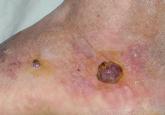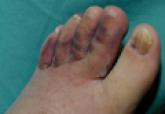Article
Kaposi Sarcoma Presenting as Yellow-Green Penile Plaques in a Black Man With HIV
Kaposi sarcoma characteristically presents with violaceous papules, plaques, or nodules due to the vascular nature of the lesions. We present the...
Syril Keena T. Que, MD; Taylor DeFelice, MD, MPH; Farah R. Abdulla, MD; David Cassarino, MD; Rishi R. Patel, MD
Dr. Que was from and Drs. DeFelice and Patel are from the New York University School of Medicine, New York. Drs. DeFelice and Patel are from the Ronald O. Perelman Department of Dermatology. Dr. Que currently is from the Department of Dermatology, University of Connecticut, Farmington. Drs. Abdulla and Cassarino are from Kaiser Permanente Fontana Medical Center, California. Dr. Abdulla is from the Department of Dermatology and Dr. Cassarino is from the Department of Pathology.
The authors report no conflict of interest.
Correspondence: Rishi R. Patel, MD, Ronald O. Perelman Department of Dermatology, New York University School of Medicine, 530 1st Ave, Ste 7J, New York, NY 10016 (rishi.patel@nyumc.org).

Kaposi sarcoma (KS) is a vascular neoplasm associated with human herpesvirus 8 (HHV-8) infection that can be confused with the clinical and histological findings of chronic venous insufficiency. Definitive diagnosis of KS can only be achieved by performing a polymerase chain reaction for HHV-8 or by immunostaining for the HHV-8 antigen. We describe 2 unusual clinical presentations of KS in the setting of chronic venous insufficiency with clinical and histologic features consistent with stasis dermatitis but positive HHV-8 immunostaining. Both patients had no known risk factors for KS. We propose the possibility that these cases may represent a new clinical variant of KS that may become more prevalent over time. Further studies are needed to identify the risk factors involved. Meanwhile, skin biopsy with HHV-8 testing may be warranted for violaceous patches and plaques arising on the legs in the setting of chronic venous insufficiency, especially in patients who are unresponsive to treatment.
Practice Points
Kaposi sarcoma (KS) is a vascular neoplasm associated with human herpesvirus 8 (HHV-8) infection that is conventionally divided into 4 clinical variants: classic, African, transplant associated, and AIDS related. In the United States, classic KS predominantly is observed in elderly white men of Ashkenazi Jewish or Mediterranean descent.1
The clinical and histological changes seen in KS can be confused with those from chronic venous insufficiency. Both conditions tend to present with purple-colored patches, plaques, or nodules on the lower extremities. Histologically, both KS and chronic venous insufficiency are characterized by blood vessel and endothelial cell proliferation in the papillary dermis, red blood cell extravasation, and hemosiderin deposition.2 Nevertheless, KS can be diagnosed based on the presence of neoplastic spindle-shaped cells and positive immunostaining for HHV-8 antigen.3
We describe the cases of 2 elderly Hispanic patients in the United States with no history of human immunodeficiency virus (HIV), immunosuppression, or travel to the Mediterranean region who presented with erythematous to violaceous papules, plaques, and nodules on the distal lower extremities in the setting of chronic venous insufficiency. We review the relationship between KS and chronic venous insufficiency and suggest that these presentations may represent a distinct clinical variant of KS.
Case Reports
Patient 1
An 83-year-old Hispanic woman with a history of hypertension, atrial fibrillation, and chronic venous insufficiency presented with a chronic painful violaceous eruption on the lower legs of 3 years’ duration. The patient reported that the erythematous patches, which she described as bruiselike, originally developed 3 years prior after starting warfarin therapy for atrial fibrillation. At that time, a biopsy indicated findings of pigmented purpuric dermatosis and negative immunostaining for HHV-8. Her condition had worsened over the last 6 months with the development of tender eroded plaques on the dorsal aspects of the feet (Figure 1) and purple-brown patches and plaques on the legs. Prior treatment with topical corticosteroids and a short course of prednisone was unsuccessful. Of note, the patient had no history of immunosuppression or HIV and was not of Mediterranean or African descent.
Punch biopsies from the left dorsal foot and left lower leg revealed dermal fibrosis, a proliferation of small blood vessels with plump endothelial cells, and foci of spindled endothelial cells with narrow slitlike spaces containing erythrocytes (Figure 2). There also were extravasated erythrocytes and a sparse inflammatory cell infiltrate comprised of lymphocytes, eosinophils, neutrophils, and plasma cells. Perls Prussian blue stain highlighted numerous siderophages scattered in the dermis. Based on these findings, immunostaining for HHV-8 was performed and highlighted reactivity of the spindled cells (Figure 3). The patient was diagnosed with KS in the setting of chronic venous insufficiency.
| Figure 2. Dermal fibrosis, proliferation of small blood vessels, and spindled endothelial cells with narrow slitlike spaces were observed (H&E, original magnification ×100). Figure 3. Spindled cells reactive to human herpesvirus 8 immunostaining (original magnification ×100). |
Patient 2
A 67-year-old Hispanic man with a history of diabetes mellitus presented with 10 asymptomatic purple papules and hyperkeratotic and hyperpigmented plaques on the distal aspect of the legs of 1 year’s duration in the setting of chronic venous insufficiency (Figure 4). The patient had no history of immunosuppression or HIV and was not of Mediterranean or African descent. An excisional biopsy from the left fourth toe revealed a cellular dermal vascular proliferation associated with numerous small slitlike vessels and scattered dilated blood vessels with prominent hemorrhage and surrounding dermal fibrosis (Figure 5). The lesion was markedly cellular with nuclear atypia. Many cells showed enlarged oval- to spindle-shaped hyperchromatic nuclei, some with prominent nucleoli and scant amounts of eosinophilic cytoplasm. Although the differential diagnosis included an unusual cellular pyogenic granuloma with atypia in the setting of chronic venous insufficiency, the degree of cellularity and presence of spindled cells associated with slitlike vessels were more consistent with a pyogenic granulomalike variant of KS. This variant is rare but has previously been reported.4 Many of the tumor nucleoli stained strongly for HHV-8, which is a diagnostic finding of KS (Figure 6). The patient subsequently was diagnosed with KS.
Comment
These 2 cases represent unusual clinical presentations of KS in Hispanic patients with no known risk factors for KS. In patient 1, an initial skin biopsy prompted HHV-8 testing due to suspicion for KS. At that time, HHV-8 was negative, perhaps because of technical deficiencies in the staining protocol; alternatively, the patient may have subsequently developed KS. Both patients had known chronic venous insufficiency. However, biopsies revealed spindle-shaped cells forming clefts and positivity for HHV-8. We propose that these cases may represent an additional clinical variant of KS, chronic venous insufficiency–associated KS.
Kaposi sarcoma characteristically presents with violaceous papules, plaques, or nodules due to the vascular nature of the lesions. We present the...

Classic Kaposi sarcoma (KS) usually is a localized and slowly progressing disease that mainly affects elderly patients; therefore, local treatment...

Kaposi sarcoma (KS) is a malignant proliferation of endothelial cells within the skin. The clinical presentation is characterized by clusters of...
